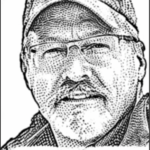By Dr. Sarah A. Orlofske, University of Wisconsin – Stevens Point
This article originally appeared in Wisconsin Waterfowl Association’s November, 2024 Newsletter edition.

Dr. Sarah Orlofske(L) and her research assistants (Roxanne, Rianna, Tyler) gave WWA President Bruce Urben and VP Todd Schaller a tour of their lab earlier this year.
Over the past few years, we have contributed several waterfowl parasite and disease related articles to this newsletter, but this is the first time we get to share some newly published research featuring contributions from your WWA!
In the latest issue of the Journal of Parasitology, this article: https://meridian.allenpress.com/journal-of-parasitology/article/110/5/445/503075/AVIAN-HAEMOSPORIDIANS-IN-GREATER-SCAUP-AYTHYA reports new results related to avian blood parasites from Greater and Lesser Scaup as well as other diving and sea ducks collected from Green Bay, Wisconsin. There were also a couple samples from Wood Ducks from a site adjacent to the Bay. Highlights of the research include detection of 14 unique types of avian blood parasites including 4 that have never been detected by scientists before! Lesser Scaup were more infected than Greater Scaup particularly females. Every species of waterfowl collected had at least one infection and dual infections – two different types of parasites in the same duck – were also present. Overall percent of ducks infected was ~27% which was slightly lower than previously published research on female Lesser Scaup collected from the Mississippi River area during a spring survey (Merrill et al. 2018). Studies of blood parasites in waterfowl are relatively rare compared to research from other types of birds like songbirds, and among waterfowl studies diving ducks are even less studied. This paper helps address this gap in our knowledge of these parasites particularly in the unique geographic area of Green Bay, WI.
Many collaborators were involved in the successful completion of this project, but we want to highlight WWA president Bruce Urben for contributing the waterfowl specimens for this project as well as writing portions of the methods.
Second author Gina Magro also wanted to share her story about this research:
Being in Dr. Orlofske’s lab brought me a better understanding of our waterfowl populations, presented opportunities for me to grow as a scientist, and provided me with the elements needed to continue my career. As a hunter myself, I have enjoyed learning how such a wide range of factors and conditions of the wetlands are affecting these birds’ health and how our parasitology research can reflect that. I feel grateful to work with so many local hunters to collect samples and get the chance to show them how impactful their contribution was through presentations and a publication. Being a part of Dr. Orlofske’s lab taught me how to reach opportunities such as my summer internship REU (Research Experience for Undergraduates) in Oregon and ending with the honor of being published. I believe this list of qualifications made the difference in my application to graduate school and helped elevate my application as a student from a small, state school, above those who attended bigger universities. This lab has shaped my career and built my confidence to work hard, learn as I go, and always say yes to opportunities even if you feel underprepared. I would like to thank the WWA and our community members for helping create the opportunities given to me during my time in Dr. Orlofske’s lab.
If you have questions about this published paper or on-going waterfowl parasite projects, please contact Dr. Sarah Orlofske (sorlofsk@uwsp.edu).
 By Bruce Ross, Executive Director bross@wisducks.org
By Bruce Ross, Executive Director bross@wisducks.org WWA focuses on helping every wannabe or existing duck hunter become the passionate conservationists that will sustain our waterfowling heritage into the future. This natural progression makes us better waterfowlers and more ethical hunters. It provides important “conservation credibility” that hunters need as hunting becomes less of the fabric of our communities and anti-hunters challenge the constitutional right to hunt.
WWA focuses on helping every wannabe or existing duck hunter become the passionate conservationists that will sustain our waterfowling heritage into the future. This natural progression makes us better waterfowlers and more ethical hunters. It provides important “conservation credibility” that hunters need as hunting becomes less of the fabric of our communities and anti-hunters challenge the constitutional right to hunt.



